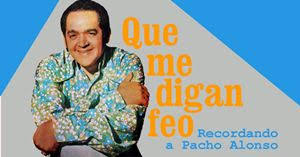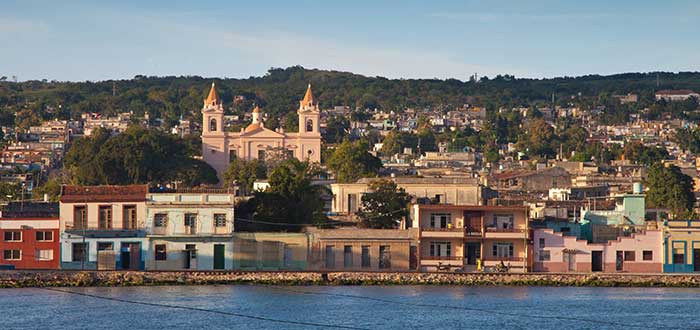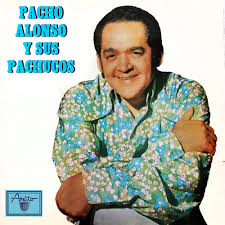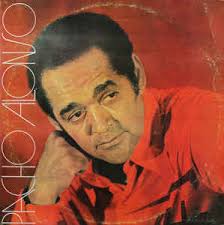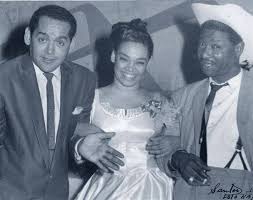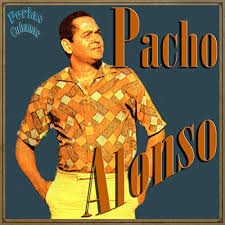PACHO ALONSO, SINGER, COMPOSER, AND BAND LEADER. “RHYTHM PILÓN”. PHOTOS/VIDEOS.
Pacho Alonso, born on August 22, 1927, in the neighborhood of La Trocha in Santiago de Cuba and was a singer and conductor who is credited with creating the musical form “pilón” in collaboration with percussionist and composer Enrique Bonne.
He made his debut on the Oriental Radio Network under the name Oscar Alonso. In 1946 he traveled to Havana and at the age of 18 he met José Antonio Méndez, who introduced him to the Mil Diez Station. However, Pacho returned to Santiago to conclude his teaching studies at the Normal School for Teachers in this city where he graduated.
In 1946, the pianist, reciter, and teacher of English, and also from Santiago, Luis Carbonell, worked as artistic director of several amateur programs at CMKC Station. Stimulated by him, Pacho Alonso, who at that time was eighteen years old, appeared on a program singing the bolero ‘Pity of you’, with which he obtained one of his first triumphs as a singer.
https://youtu.be/O95JB4TE8xQ
Press ^ Here
Pacho Alonso sings.
Shortly after, he visited the city of Havana on the occasion of a sports competition, an occasion that the young artist took advantage of to appear at the Mil Diez Station where he was encouraged by the composer José Antonio Méndez and the conductor Bebo Valdés.
In 1948 he was presented by the animator Gualterio Núñez in the Revista Popular del Aire of the Eastern Radio Network, accompanied by the orchestras of Pancho Portuondo and Chepín-Chovén.
When the notable oriental saxophonist Mariano Macerón returned from Mexico in 1950 and the following year organized his own jazz band dance orchestra, he joined three of the most promising vocalists of that time in the city of Santiago: Pacho Alonso, Fernando Álvarez, Alfonso Eliseo (Juan Carón) and later the unforgettable Beny Moré, who by those years was already a consecrated person for his recordings in Mexico with the famous Dámaso Pérez Prado Orchestra.
https://youtu.be/rTkKLbqIZT0
Press ^ Here
Pacho Alonso and D’Aidas.
From 1951 to 1954, Pacho Alonso, together with maestro Mercerón, carried out extensive work as an orchestra singer, performing in countless popular dances, cabarets, and in different programs on the Oriental Radio Network and on other stations in his hometown.
His first group founded in 1952: Pacho Alonso and his Modernistas. From the first moments, he impregnated the group with him as a fundamental characteristic, his marked accentuation, eminently from Santiago. With such recognition from the dancing public, he obtained his first triumphs on the stages of nightclubs such as El Copa Club and San Pedro del Mar.
In the mid-1950s he recorded his first album: Cha-Cha-Cha de la Reina, a successful creation by Enrique Bonne accompanied by the Mercerón orchestra.
In 1957, Pacho appeared for the first time on television for a week with his group on the program “El Show del Mediodía”, on channel 6 of CMQ TV. That same year he recorded for the GEMA albums the numbers entitled Meñoñón (son montuno) and Serenata de Haiti.
With that firm decision at the end of the fifties, Pacho settled in Havana, and as the first step in 1958, he restructured his group under the name of Pacho Alonso and his Bocucos. In the 1950s, Alonso sang with Benny Moré and Fernando Álvarez, a trio popularly known as “Los Tres Mosqueteros.”
In 1959 he was hired by RCA Víctor, a firm with which he records hits such as “Yo no quiero piedra en mi Camino” (Enrique Bonne), and an album of great popular impact, with the boleros “Imágenes”, by Frank Domínguez and ” You don’t suspect “, by Martha Valdés.
In the late 1950s and first half of the 1960s, the movement called Feeling was fully defined. FROM 1958 to 1961, Pacho’s peculiar style was consolidated, within this new way of composing and approaching a popular song. Performing at the Havana nightclubs Le Mans and Scheherazade.
He worked closely with other cultivators of the genre such as the singers Elena Bourke, Elsa Balmaceda, Orlando Fierro, Gina León, Dandy Crawford, and the Duet of René and Nelia, who also gave their valuable contributions, and with the accompaniment of the pianists Frank Domínguez, Pepe Delgado and Frank Emilio, among others no less remarkable, Pacho achieved a unification between the composer and the interpreter that contributed new emotional elements to the Cuban popular song.
After the Triumph of the Revolution, a stage full of new vigor and ambitious plans open for Pacho. The projects of his future career were more closely linked to his whole. Pacho Alonso and his Bocucos already had his musical style well defined, based, according to Pacho himself, on a mixture of guapacha and different touches from the French Tomb of Haitian origin.
It was in 1960 that Victor received the Gold Record from RCA Víctor, in Medellín, Colombia for his outstanding popularity with La Pachanga. His first full-length album came out in early 1961. It is titled “A night at the Scheherezade with Pacho Alonso” and includes the aforementioned “Images” and “Tú no sospechas”, as well as “Enferma del alma”.
Starting in 1961, Pacho Alonso and his Bocucos began an outstanding musical work by performing at carnivals in several provinces, the great stages of the Night and Day cabarets, Hotel Habana Libre, Tropicana, Nacional, Havana Rivera. His attractive figure is frequently requested in different television programs of those years such as “El Show de Arau”, “Phillips Album”, “Thursday of Partagás”, “Cuban Night”, “Musical Monday” and “Casino de la Alegría.
In them, he alternated with artistic personalities of the stature of Beny Moré, Rosita Fornés, Ramón Velóz, Sonia Calero, Alberto Alonso, Luis Carbonell, Trío Matamoros, Cuarteto D’Aida, and Bola de Nieve. He recorded his second full-length for Víctor, where he included his Bocucos alternating with the Bebo Valdés and Juanito Márquez orchestras, and where he sang great hits of his career such as the guaracha ‘Que me digan feo’, ‘el rhythm joker’ ‘Anyone dies uncle’, by Enrique Bonne, and the unexpected son montuno by Martha Valdés entitled, ‘Surprise of flour with sweet potato’.
THE RITMO PILON IS CREATED
In 1964, composer Enrique Bonne, a great friend of Pacho, proposed to him the incorporation of his new rhythm called pilón. This modality, with antecedents in the eastern organ, takes its name from the rustic instrument where the peasants ground coffee. The pylon was the pinnacle of success for the Alonso-Bonne duet. From the first moments, the rhythm caught between the members of Los Bocucos,
which with their touches and suggestions finished outlining the Ritmo Pilón, together with the invaluable contributions in the field and the dance created by Pacho Alonso himself None of the variants later developed by them, such as the Simalé and the UPA UPA, although they were very popular, they achieved that level of popularity.
In 1967 Pacho decided to form a new group called Pacho Alonso y sus Pachucos, which was characterized by a more contemporary timbral sound to which Pacho added a new repertoire.
During the 1970s, Pacho traveled to various countries in America and Europe. At the end of that decade, he joined the orchestra with his son Pachito, very young but already an outstanding pianist and arranger. Pacho ended up giving him the leadership of the band. Under the direction of his son, songs such as “Met Pedro el Cojo”, “El Guayabero” and “Algo Contigo” were recorded.
In 1978, Pacho Alonso and his Pachuchos traveled to Spain again, where they performed with customary success in Zaragoza, Barcelona, La Coruña, Madrid, Aragón, Huelva and Llogregat. Back in Cuba, he centralized the Pacho Alonso-style show at the Cabaret Copa Room, at the Hotel Havana Rivera, and that year he participated in the Festival del Son.
A year before his sudden death, in the City of Havana, on August 28, 1982, the Cuban state had awarded Pacho Alonso the Medal for National Culture. In this way, the great contributions of his to Cuban popular music and his joy of living were recognized on behalf of his people.
Pacho Alonso also enjoyed tremendous success on his international tours of Latin America, Europe, and Africa. His music still makes Cubans dance because of its rhythm and lyrics.
(READ PACHO ALONSO PERFORMANCES AND DISCOGRAPHY IN THE SPANISH SECTION)
PACHO ALONSO, CANTANTE, COMPOSITOR Y DIRECTOR DE ORQUESTA CUBANO. RITMO PILÓN.
Pacho Alonso, nacido un 22 de agosto de 1927 en el barrio de la Trocha en Santiago de Cuba y fue un cantante y director de orquesta a quien se le atribuye la creación de la forma musical “pilón” en colaboración con el percusionista y compositor Enrique Bonne.
Debutó en la Cadena Oriental de Radio con el nombre de Oscar Alonso. En 1946 viajó a La Habana y a los 18 años conoció a José Antonio Méndez, quien lo presentó en la Emisora Mil Diez. Sin embargo Pacho regresó a Santiago para concluir sus estudios de magisterio en la Escuela Normal para Maestros de esta ciudad donde se graduo.
En 1946, el pianista, recitador y profesor de inglés, y también santiaguero, Luis Carbonell, laboraba como director artístico de varios programas de aficionados en la Emisora CMKC. Estimulado por éste, Pacho Alonso, que por esa época contaba dieciocho años, se presentó en un programa cantando el bolero ‘Lástima de ti’, con el cual obtuvo uno de sus primeros triunfos como cantante.
https://youtu.be/ZaUHZonHjuM
Presione ^ Aqui
Pacho Alonso canta “Que ME Digan Feo”.
Poco después visitó la ciudad de La Habana con motivo de una competencia deportiva, ocasión que aprovechó el joven artista para presentarse en la Emisora Mil Diez donde fue estimulado por el compositor José Antonio Méndez y el director de orquesta Bebo Valdés.
En 1948 fue presentado por el animador Gualterio Núñez en la Revista Popular del Aire de la Cadena Oriental de Radio, acompañado por las orquestas de Pancho Portuondo y Chepín-Chovén.
Cuando el notable saxofonista oriental Mariano Macerón regresó de México en 1950 y al año siguiente organizó su propia orquesta de baile, tipo jazz band, integró a la misma a tres de los vocalista más prometedores de ese momento en la ciudad de Santiago: Pacho Alonso, Fernando Álvarez, Alfonso Eliseo (Juan Carón) y más tarde al inolvidable Beny Moré, que por esos años era ya un consagrado por sus grabaciones en México con la famosa Orquesta de Dámaso Pérez Prado.
De 1951 a 1954, Pacho Alonso, junto al maestro Mercerón, realizó una extensa labor como cantante de orquesta, actuando en infinidades de bailes populares, cabarets y en distintos programas en la Cadena Oriental de Radio y en otras emisoras de su ciudad natal.
https://youtu.be/sa3ttnlPmcQ
Presione ^ Aqui
Pacho Alonso y otros.
Su primer grupo lo fundó en 1952: Pacho Alonso y sus Modernistas. Desde los primeros momentos, le impregnó a su grupo como característica fundamental, su marcada acentuación, eminentemente santiaguera. Con tal reconocimiento por parte del público bailador, obtuvo sus primeros triunfos en los escenarios de los centros nocturnos como El Copa Club y San Pedro del Mar.
A mediados de la década de los cincuenta grabó su primer disco: Cha-Cha-Cha de la Reina, exitosa creación de Enrique Bonne acompañado por la orquesta de Mercerón.
En 1957, Pacho se presentó por primera vez en la televisión durante una semana con su conjunto en el programa «El Show del Mediodía», del canal 6 de CMQ TV. Ese mismo año grabó para los discos GEMA los números titulados Meñoñón (son montuno) y Serenata de Haití.
Con esa firma decisión a finales de la década del cincuenta Pacho se radicó en La Habana, y como primer paso en 1958 reestructuró su conjunto con el nombre de Pacho Alonso y sus Bocucos. En la década de 1950, Alonso cantó con Benny Moré y Fernando Álvarez, un trío conocido popularmente como “Los Tres Mosqueteros”.
https://youtu.be/0ZX5MJKK-bQ
Presione ^ Aqui
Pacho Alonso canta.
En 1959 fue contratado por la RCA Víctor, firma con la cual graba éxitos como “Yo no quiero piedra en mi camino”(Enrique Bonne), y un disco de gran impacto popular, con los boleros “Imágenes”, de Frank Domínguez y “Tú no sospechas”, de Martha Valdés.
A finales de las décadas del cincuenta y primera mitad del sesenta, el movimiento denominado Feeling quedó plenamente definido. DE 1958 a 1961, el estilo peculiar de Pacho se consolida, dentro de está nueva manera de componer y abordar la canción popular. Presentandose en los centros nocturnos habaneros Le Mans y Scheherazada.
Laboró estrechamente con otros cultivadores del género como los cantantes Elena Bourke, Elsa Balmaceda, Orlando Fierro, Gina León, Dandy Crawford y el Dúo de René y Nelia, que dieron también sus aportes valiosos, y con el acompañamiento de los pianistas Frank Domínguez, Pepe Delgado y Frank Emilio, entre otros no menos notable, Pacho logró una unificación entre el compositor y el intérprete que aportó nuevos elementos emotivos en al canción popular cubana.
Después del Triunfo de la Revolución, se abre para Pacho una etapa llena de nuevos bríos y planes ambiciosos. Los proyectos de su carrera futura estuvieron más estrechamente ligados a su conjunto. Pacho Alonso y sus Bocucos ya tenía bien definido su estilo musical, basado según el propio Pacho, en una mezcla de guapacha y distintos toques de la Tumba Francesa de origen haitiano.
Fue en 1960 que recibe de la RCA Víctor el Disco de Oro, en Medellín, Colombia por su descollante popularidad con La Pachanga. Su primer disco de larga duración salió a principios de 1961. Se titula “Una noche en el Scheherezada con Pacho Alonso” e incluye los ya mencionados “Imágenes” y “Tú no sospechas”, además de “Enferma del alma”, “Tú no sospechas”, “Calor de nido”, “Dame un chance”, “Tú sabes mucho”, “Dímelo con besos”, “Se tambalea”, “Lo mismo da”, “Son cosas que pasan” y “No pienses así”.
A partir de 1961, Pacho Alonso y sus Bocucos iniciaron una descollante labor musical actuando en los carnavales en varias provincias, los grandes escenarios de los cabarets Night and Day, Hotel Habana Libre, Tropicana, Nacional, Havana Rivera. Su atractiva figura es solicitada frecuentemente en distintos programas de televisión de aquellos años como «El Show de Arau», «Álbum Phillips», «Jueves de Partagás», «Noche Cubana», «Lunes Musical» y «Casino de la Alegría».
En ellos alternó con personalidades artísticas de la envergadura de Beny Moré, Rosita Fornés, Ramón Velóz, Sonia Calero, Alberto Alonso, Luis Carbonell, Trío Matamoros, Cuarteto D’Aida y Bola de Nieve. Grabó su segundo larga duración para la Víctor, donde incluyó a sus Bocucos alternando con las orquestas de Bebo Valdés y la de Juanito Márquez, y donde cantó grandes éxitos de su carrera como la guaracha ‘Que me digan feo’, ‘el ritmo guasón’ ‘A cualquiera se le muere tío’, de Enrique Bonne, y el inesperado son montuno de Martha Valdés titulado, ‘Sorpresa de harina con boniato’.
SE CREA EL RITMO PILÓN
En 1964, compositor Enrique Bonne, gran amigo de Pacho, le propone a este la incorporación de su nuevo ritmo denominado pilón. Esta modalidad, con antecedentes en el órgano oriental, toma su nombre del rústico instrumento donde los campesinos molían el café. El pilón significó la cumbre del éxito del dueto Alonso-Bonne. Desde los primeros momentos el ritmo prendió entre los integrantes de Los Bocucos,
los cuales con sus toques y sugerencias acabaron de perfilar el Ritmo Pilón, junto a los valiosísimos aportes en el campo y el baile creados por el propio Pacho Alonso Ninguna de las variantes posteriormente desarrolladas por ellos, como el Simalé y el UPA UPA,aunque fueron muy populares, lograron ese nivel de popularidad.
En 1967 Pacho decide formar un nuevo grupo llamado Pacho Alonso y sus Pachucos, el cual se caracterizaba por una sonoridad tímbrica más contemporánea al que Pacho incorporó un repertorio nuevo.
Durante la década del setenta, Pacho viajó por varios países de América y Europa. A finales de esa década incorporó a la orquesta a su hijo Pachito, muy joven pero ya destacado pianista y arreglista. Pacho terminó por entregarle la conducción de la banda. Bajo la dirección de su hijo se grabaron temas como “Conocí a Pedro el Cojo”, “En Guayabero” y “Algo Contigo”.
En 1978, Pacho Alonso y sus Pachuchos viajaron de nuevo a España, donde se presentaron con el éxito acostumbrado en Zaragoza, Barcelona, La Coruña, Madrid, Aragón, Huelva y Llogregat. De regreso a Cuba, centralizó el show a lo Pacho Alonso, en el Cabaret Copa Room, del Hotel Havana Rivera, y participó ese año en el Festival del Son.
Un año antes de fallecer de forma repentina, en la Ciudad de La Habana, un 28 de agosto de 1982, el estado cubano le había otorgado a Pacho Alonso laMedalla por la Cultura Nacional. De ese modo se le reconoció a nombre de su pueblo sus grandes aportes a la música popular cubana y a su alegría de vivir.
Pacho Alonso también disfrutó de un tremendo éxito en sus giras internacionales por América Latina, Europa y África.
Su música todavía hace bailar a los cubanos por su ritmo, letra y movimiento.
DISCOGRAFIA
Algunas de sus interpretaciones.
Micaela/Conocí a tu papá, P. Alonso.
Niebla del riachuelo/b, Cadicamo.
Que me digan feo/gu Enrique Bonne-Pacho Alonso.
Qué quieres que te diga/cha, DR.
Que seas feliz/No/b, Consuelo (Chelo) Velazquez.
Sabor a mí/b, Álvaro Carrillo.
Yo no quiero piedra en mi Camino/gua, Enrique Bonne.
Imágenes/b, Frank Domínguez.
Enferma del alma/b, Otilio Portal.
Dame un chance/s-mt, ER.
Tú no sospechas/c Martha Valdés.
Tú sabes mucho/b, Pedro Vega.
Se tambalea/rt-pilón Enrique Bonne.
Dímelo con besos/ b, FB.
Don resolvió y cualquiera es/pilón, Enrique Bonne y Pacho Alonso.
Ay que pena Mariana/ pch, Enrique Bonne.
Entre muchos otros.
PREMIOS.
Se le otorgó, por Fin del milenio, el Premio Cubadisco 2000 en la categoría Música de archivo.
Agencies/ Wiki/ Ecured/ Extractos/ Excerpts/ Internet Photos/ YouTube/ Arnoldo Varona/ www.TheCubanHistory.com
THE CUBAN HISTORY, HOLLYWOOD.



